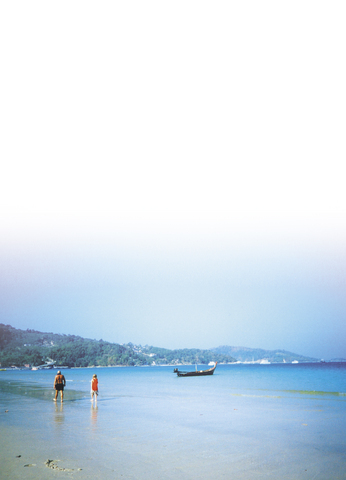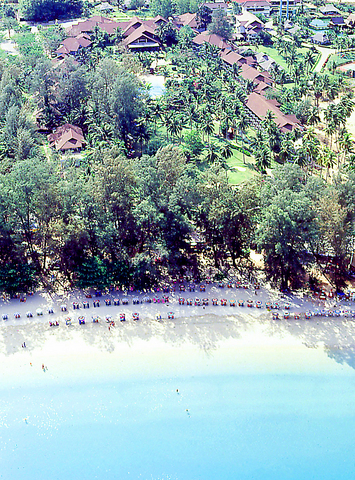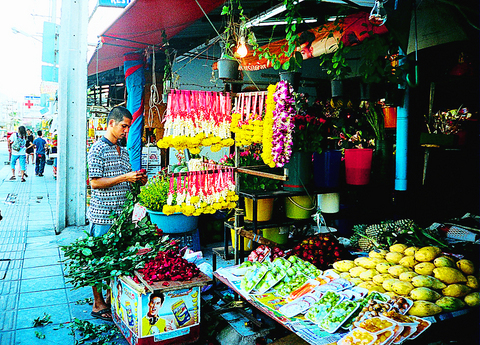Many people's first reaction upon hearing of a visit to Thailand's famous Phuket Island or other tourist destinations in the area is "But wasn't it all destroyed in the tsunami?"
They refer, of course, to the massive tidal wave of Dec. 26 last year that swept thousands of people to their deaths and laid waste to coastal areas in Indonesia, Sri Lanka, India, Malaysia and Thailand.
Phuket, specifically the west side of the island -- the east coast sustained very little or no damage whatsoever -- wasn't spared the tsunami and the images that stick in the mind are those of unsuspecting tourists in the wrong place at the wrong time.

That was then.
In fact, Phuket and Thailand's five other tsunami-hit provinces were not hit nearly as hard as Indonesia or Sri Lanka, where entire villages disappeared under the wave.
Locals are nearly unanimous in their condemnation of media reports at the time, saying the level of destruction was overstated and that false claims about the loss of life were made.

PHOTO: PEARL VILLAGE
The amount of media that flew in and set themselves up as immediate experts on all things Thai was quite a circus to observe, they say. Many journalists were based in five-star hotels on Phuket's beaches, yet their respective reports aired footage of Banda Aceh and Sri Lanka, giving viewers a false impression of what had happened in Phuket.
In reality, the island's residents immediately started the clean-up effort and worked days and nights to remove debris from the beaches. They know better than anyone that the island is heavily dependent on tourism and if no one returned to Phuket, their livelihoods would also disappear.
The island's famous Patong, Kata and Karon beaches all sustained some degree of damage, mostly to the tourist-traps and shops along the beachfronts.

PHOTO: CARINA MCINTOSH
The beaches themselves, meanwhile, have been restored to a degree of pristine beauty not seen for many years, and the sand quality and water quality have improved significantly.
Locals are quick to point out that one can now swim at Patong Beach without fear of eye infections and skin rashes.
"The beach is like it was at the beginning of tourism 30 years ago," Somchai Silapananon of the Phuket Tourism Association said before the start of the "Love Andaman" festival held on the island at the beginning of this month.

PHOTO: CARINA MCINTOSH
The festival was planned by the Tourism Authority of Thailand (TAT), Thai Airways International and the Federation of Thai Industries to restore confidence in the tourism industry and to help Thailand's six tsunami-hit provinces on the Andaman Sea coast.
"Only 10 percent to 20 percent of shallow-water coral reefs were destroyed and most of the prime diving sites now offer even better diving, thanks to the improved water quality," TAT president Wichit Na-Ranong said.
In Patong, the improved water quality could be attributed in part to damaged beachfront hotels currently being closed for rebuilding and redecoration and the resulting reduction in waste-water output.

Fishermen have also noted rises in catches of up to 100 percent and the return of fish species that had not been seen in reef areas for years because of deteriorating water quality. Many of them are saying that the tsunami opened up ancient natural underwater "food channels" and breeding grounds that might have been clogged or sanded up for centuries because of human activities in the region.
The main concern of the Patong hospitality industry is to ensure that the improved water quality is maintained.
"Once all the businesses return, it will be hard to maintain the pristine quality," Patong hotelier Lily Udomkunatum said.
Unfortunately, the "Love Andaman" festival had to be cancelled after a huge storm swept over the island, flooding the venue on the beach and collapsing the massive stage that had taken three days to construct.
The storm also knocked out most of the electricity in Patong, which meant that most restaurants and bars either closed for the night or used candles and lamps to provide light, turning the normally neon-illuminated Rat-U-Tit Road into a fairyland of flickering flames.
No electricity also meant that none of the automatic bank teller machines in the area were working and some visitors -- myself included -- were stuck without cash.
Fortunately, the hospitality industry in Patong is geared to cope with any disaster, so when we entered the Aussie Bar -- one of the liveliest bars on Soi Easy just off the bustling red-light area on Bangla Road -- not having ready cash was not a problem. The very understanding Australian expat owner merely shrugged it off with "It happens sometimes," and allowed the entire group to eat and drink on a tab.
The check could be settled later when the teller machines were up and running again, he said, without raising an eyebrow -- now that's hospitality.
Another excellent example of nature restoring what man -- and in this case Hollywood -- has destroyed, is Ao Maya, or Maya Bay. The bay that was put on the international tourist map by the Leonardo DiCaprio backpacker epic, The Beach, is tucked into Phi Phi Leh, a tiny, uninhabited island that is part of a national park next to the main resort island, Phi Phi Don, off Krabi.
In 1999, the film's producers cleaned the bay of rubbish, stripped the vegetation, planted a grove of coconut palms on the beach and levelled the sand dunes. Locals say the beach never recovered.
"The sand dunes were damaged during filming because there is a scene where the actor had to play soccer on the beach and the beach did not have a wide enough space so they brought in a tractor to widen it," said Nattawuth Kaenthong, a Phi Phi resident.
With the first monsoonal storms, Nattawuth said, all the sand was washed away. The Thai government had to use sacks of sand to replace the flattened dunes.
"Before the tsunami hit there were no sand dunes at all. But afterwards, everything came back just like the old times," Nattawuth said.
Marius Goring of Bangkok told me that when he last visited Phi Phi for a few days a year ago, he vowed never to go back to the islands because of the disgusting state they had fallen into before the tsunami.
He said the beaches were so crammed full of boats that there was no room for tourists to swim even if they wanted to risk being covered by oil leaking from the boats' engines. A foul smell hung in the air, Goring said, and some of the beaches had the appearance of an open sewer.
After the tsunami, however, boat traffic to the islands has decreased and the rejuvenated beaches again sport the clear, azure water that made them such inviting tourist destinations in the first place.
On the Krabi mainland the Hat Noppharat Thara -- Koh Phi Phi National Marine Park suffered minimal damage but repairs have been made and the beaches have already returned to normal tourist capacity.
Further south, Hat Rai Leh and Hat Tham Phra Nang, two of the most beautiful beaches in Krabi, were hardly touched by the giant wave.
Most of the debris on Krabi's damaged beaches has been cleared and recovery work is well underway. All tourist accommodations on the east side of Phi Phi Don -- including the Holiday Inn Phi Phi Island, Phi Phi Island Village Resort, PP Coral Resort and Spa, and Phi Phi Natural Resort -- are open for business, as are those along Hat Yao at the island's southeast corner. Ferries to Phi Phi Don from Krabi and Phuket are in operation once again.
In short, there hasn't been a better time to head to Phuket or Krabi for an island-paradise holiday most people can only dream about.
Instead of destroying the natural beauty of the area, the tsunami in this case flushed away the garbage and filth and left a paradise rejuvenated and restored to its natural splendor, enjoying a welcome respite from pollution and overcrowding.

Taiwan can often feel woefully behind on global trends, from fashion to food, and influences can sometimes feel like the last on the metaphorical bandwagon. In the West, suddenly every burger is being smashed and honey has become “hot” and we’re all drinking orange wine. But it took a good while for a smash burger in Taipei to come across my radar. For the uninitiated, a smash burger is, well, a normal burger patty but smashed flat. Originally, I didn’t understand. Surely the best part of a burger is the thick patty with all the juiciness of the beef, the

The ultimate goal of the Chinese Communist Party (CCP) is the total and overwhelming domination of everything within the sphere of what it considers China and deems as theirs. All decision-making by the CCP must be understood through that lens. Any decision made is to entrench — or ideally expand that power. They are fiercely hostile to anything that weakens or compromises their control of “China.” By design, they will stop at nothing to ensure that there is no distinction between the CCP and the Chinese nation, people, culture, civilization, religion, economy, property, military or government — they are all subsidiary

Nov.10 to Nov.16 As he moved a large stone that had fallen from a truck near his field, 65-year-old Lin Yuan (林淵) felt a sudden urge. He fetched his tools and began to carve. The recently retired farmer had been feeling restless after a lifetime of hard labor in Yuchi Township (魚池), Nantou County. His first piece, Stone Fairy Maiden (石仙姑), completed in 1977, was reportedly a representation of his late wife. This version of how Lin began his late-life art career is recorded in Nantou County historian Teng Hsiang-yang’s (鄧相揚) 2009 biography of him. His expressive work eventually caught the attention

This year’s Miss Universe in Thailand has been marred by ugly drama, with allegations of an insult to a beauty queen’s intellect, a walkout by pageant contestants and a tearful tantrum by the host. More than 120 women from across the world have gathered in Thailand, vying to be crowned Miss Universe in a contest considered one of the “big four” of global beauty pageants. But the runup has been dominated by the off-stage antics of the coiffed contestants and their Thai hosts, escalating into a feminist firestorm drawing the attention of Mexico’s president. On Tuesday, Mexican delegate Fatima Bosch staged a